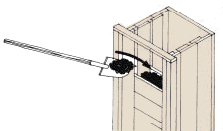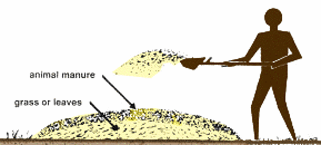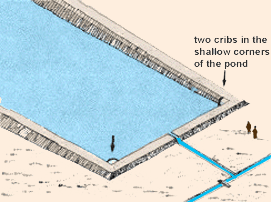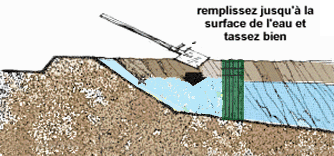8. PREPARING YOUR POND
BEFORE FILLING THE POND(191) Make sure that the screens on the inlet, outlet and overflow are in place and tight. (192) Make sure that the outlet is tightly closed. To do this, wrap a wood plug with old cloth, put it in the outlet pipe on the outside of the pond and tap it lightly with a hammer so that it will stay in the pipe when the pond fills with water.
|
|
|
(193) If you have built a better outlet with a T or an L piece, turn it to the upright position.
|
(194) If your pond has a monk, put in the boards and put the screen on top (see items 113 to 119).
|
|
|
(195) Put rocks on the bottom of your pond under the inlet where the water will fall when it begins to come into the pond.
|
(196) This will keep the bottom from washing away. It will keep the water from getting too muddy. It will make the water splash when it first comes into the pond and bring air for the fish to breathe. (197) Now you are ready to fill your pond. |
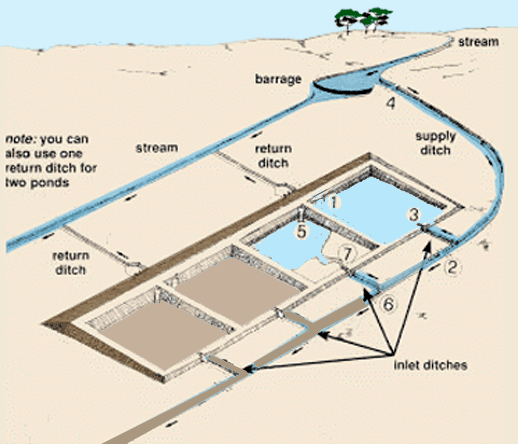
|
|
Note: make sure that some water is always running down the supply ditch and into each of your ponds so that they will always be full |
HOW TO FILL A POND WHEN YOU HAVE A MONK |
||
|
1 - put both sets of wooden boards in the
|
2 - the boards should be as high as the water |
|
|
3 - pack the space between them with good
|
4 - let water into the pond  |
|
|
5 - when the water reaches the top of the boards,
Note: you may have to let water into your pond from time to time if the water level gets too low |
6 - leave the screen in place to act as an
|
FERTILIZING THE WATER(198) You can fertilize the water in your new ponds with
|
(199) You can also fertilize your ponds by soaking bitter cassava roots in the water, at regular intervals. |
HOW TO MAKE PLANT COMPOST(200) Items 202 to 209 tell you how to make animal compost. If you do not have animal manure, you can fertilize your ponds with compost made with plant material. (201) To make compost with plant material, make a compost pile using layers of grass, chopped leaves or other plant material mixed with a little topsoil. Dampen it with water to make it rot faster. |
 |
HOW TO MAKE ANIMAL COMPOST(202) Make a compost pile near the pond. Put it in a shady place protected from rain.
|
(203) Make your pile in layers. Make the first layer of grass or leaves mixed with a spadeful of topsoil, and dampen it with water to make it rot faster. (204) Then make a second layer of animal manure mixed with a spadeful of topsoil and some water.
|
|
(205) Use animal manure from sheep, goats, cattle, pigs, chickens or ducks.
|
(206) In place of animal manure you can also use cotton seed, spoiled fruit, household garbage, ashes from the fireplace or night soil.
|
|
|
(207) Then make another layer of grass or leaves, and another
of manure, until you have a large pile.
|
(208) Keep your compost pile damp by watering it every few days. (209) Let the compost pile rot for about a month.
|
|
(210) Take compost from the bottom of the pile or the old part of the pile, where it is most rotten, to put in your ponds.
|
(211) Add new layers to your pile every week so that you will always have compost. (212) If you have too much compost you can use some to fertilize your land. |
BUILDING A CRIB(213) In each pond build a crib from bamboo or wood to hold the fertilizer. Build it in one corner in the shallow part of the pond.
|
(214) If you have a pond that is bigger than 500 square metres, you should build two cribs in the pond. The drawings below show you where to put them.
|
|
|
|
PUTTING FERTILIZER INTO THE CRIB(215) When you first put fertilizer into your
crib, pack it down well and fill the crib to the water line. This
will be about 60 centimetres deep in the shallow part of the pond.
|
|
|
|
(216) If you are going to fertilize your ponds with animal compost you will need to put in
(217) If you are going to fertilize your ponds with animal manure you will need to put in |
|
|
|
or
|
|
|
or
|
|
|
(218) If you are going to fertilize your ponds with animal manure, but you do not have enough of any one kind of animal manure, you can make a mixture of several kinds. |
||
|
(219) You can make a mixture using 1 part poultry droppings, 2 parts pig dung and 3 parts cow dung. You will need to put in
|
|
WHEN IS YOUR POND READY?(220) If you fertilize your pond with animal compost or animal manure, the water will start to turn green in two or three days. If you fertilize your pond with plant compost or plant material, it will take one week or longer. (221) When the water begins to turn green, you will know that natural food is growing in your pond. It will take about a week to become green enough. (222) You can make a simple test to be sure that the water is green enough. Put your arm in the water up to your elbow. If you are just able to see the ends of your fingers, the water is green enough. |
|
Summary
YOU HAVE LEARNED HOW TO PREPARE EACH POND TO RECEIVE FISH
Check the screens, close the outlet, open the inlet and protect the bank under it
Fill the pond with water
Fertilize the water:
- build a crib in the shallow end of the pond
- fill it with compost, manure or plant wastes
- pack it well under water, up to the water level
Wait until the water becomes rich in natural fish food
- the water turns green
- it becomes less transparent






